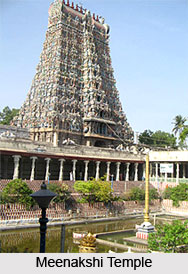 Madurai is one of the oldest cities of the Indian state of Tamil Nadu. It was ruled by different Empires. There are various beautiful places around the Madurai city. Some of them are given here:
Madurai is one of the oldest cities of the Indian state of Tamil Nadu. It was ruled by different Empires. There are various beautiful places around the Madurai city. Some of them are given here:
Meenakshi Temple in Madurai
This temple is situated in the midst of the Madurai city. The Meenakshi temple is an important landmark and nucleus of the life of the city. There are 11 gopurams in this temple and the tallest of them is at the southern portal rising to a height of 200 ft. This portion is completely dedicated to Goddess Meenakshi. The entrance of the temple is from Vittavasal Street. It is adorned by the Ashtalakshmi i, e, eight forms of Goddess Lakshmi Mandapam.
On the temple ceiling, the scenes of Kumara Sambhava and the marriage of Goddess Meenakshi with Sundareswara are painted. The statues of Subramanya and Vinayaka can be seen at the entrance. The passage is the beautiful sculpture of Siva and Meenakshi as a huntress. The mandapam has thousand pillars and it is a real museum of Dravidian art and architecture. The Ardhanari idol carved by Thirumalai Nayak can also be seen here. The sculptures of Lord Nataraja can be seen here in a different style instead of raising his left leg up, he plays it vice versa. The dancing hall here is called Velliambalam and the idol is plated with silver.
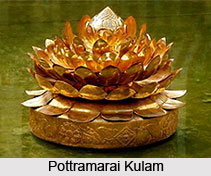 The Temple Museum of Madurai
The Temple Museum of Madurai
This museum can be seen in the 1000 pillared mandapam. There are 985 richly carved pillars in the temple museum and each one of them is different from the other. The Vasantha Mandapam or Pudumandapam of this temple museum of Madurai has more scenes of the wedding ceremony. The spring festival is held here in April-May.
Oonjal Mandapam of Madurai
This mandapam is situated on the western end of the tank called Pottramarai Kulam. There is a swing here on which Goddess Meenakshi and Her consort Lord Siva are seated and worshipped every Friday.
The Kilikoottu Mandapam or hall of parrots can be seen near to it. There are beautiful sculptures with caged parrots can be found here that chant the name of Meenakshi.
There are total 12 gopurams of this mandapam. The tallest four among them stand at the outer walls. The southern gopuram is the tallest of them and is the most impressive and has over 1500 sculptures. The panoramic view of the city can be seen from its top.
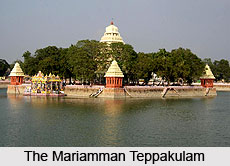 There are eight smaller gopurams within the compounds of the twin temples. It is so huge that new visitors may lose their way. Therefore, it is better to go with a guide or with a person who had already been there several times.
There are eight smaller gopurams within the compounds of the twin temples. It is so huge that new visitors may lose their way. Therefore, it is better to go with a guide or with a person who had already been there several times.
The Mariamman Teppakulam of Madurai
This is a tank, which is also known as Vandiyur Teppakulam. It is about 5 kms east of Meenakshi temple. It covers an area equal to the twin-temple complex. Thirumalai Nayakar built this tank. There is an island in the middle and also a temple for Ganesa. The tank was constructed due to digging of earth to make bricks for the Thirumalai Nayak palace. This tank is 1000 ft long and 950 ft wide and four white turrets border the garden of the island. In this tank, the float festival of the Meenakshi Amman temple is held in January-February.
The Thirumalai Nayak Mahal of Madurai
This is a palace of Thirumalai Nayak, which is situated just a km away from the temple. This is an Indo-Saracenic architecture, which was constructed in 1523A.D. The granite pillars of it are cased with mortar and the supporting arches present a majestic view. There are towers in the corner of the east face.
The Swarga Vilasam or the audience hall is the most significant part of this structure. The dome of it is 60 ft in diameter and 70 ft in height. This high dome stands firm without any support, which shows the engineering skill of its builders. The zenana surrounds the dome from where the royal ladies used to view the durbar. The fine architectural style of the Nayakas is represented by it.
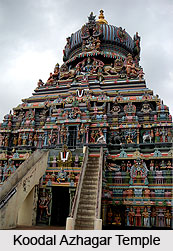 The tourists can visit there from 9 a.m. to 1 p.m. and from 2 p.m. to 5 p.m by paying a minimum entrance fee of Rs.l. Everyday, the sound and light shows on the life of Thirumalai Nayak and the story of Silappathikaram is organised here at 06.45pm.
The tourists can visit there from 9 a.m. to 1 p.m. and from 2 p.m. to 5 p.m by paying a minimum entrance fee of Rs.l. Everyday, the sound and light shows on the life of Thirumalai Nayak and the story of Silappathikaram is organised here at 06.45pm.
Koodal Azhagar Temple of Madurai
In Madurai, Lord Vishnu is known as Koodal Azhagar and this is one of the Vishnu temples of the city. Here, no tall gopurams can be found and the Vimana is called `Ashtanga`. It stands in the centre with diminishing tiers under which the sanctum lies. The base of this temple has excellent carvings.
The Tamakam of Madurai
It is a beautiful remnant of Thirumalai Nayak. It looks like his Palace, the Mahal. The Lotus Hall here has a dome with ceiling, shaped like an inverted lotus. The Nayaka`s used it as their summer palace.
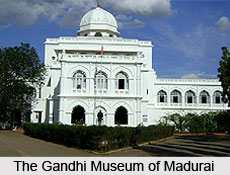 Goripalayam Mosque of Madurai
Goripalayam Mosque of Madurai
There is a large mosque in Goripalayam containing two tombs of two Delhi Sultans of the Madurai sultanate. Here, the dome is 70 ft. in diameter and 20 ft. in height. But, the strange fact is that it was made of a single block of stone. It is said that Thirumalai Nayak built this for his Muslim subjects.
The Gandhi Museum of Madurai
This museum contains a picture gallery, a gallery of relics, a Khadi and Village Industries section and a South Indian handicrafts section. It is situated in an old palace.



















